
CAIN Web Service
Symbols Used in Northern Ireland
- A Short Essay on Symbols by Dara Mulhern
[CAIN_Home]
[Key_Events]
[Key_Issues]
[CONFLICT_BACKGROUND]
BACKGROUND: [Acronyms]
[Glossary]
[NI Society]
[Articles]
[Chronologies]
[Organisations]
[CAIN_Bibliography]
[Other_Bibliographies]
[Research]
[Photographs]
[SYMBOLS]
[Murals]
[Maps]
[Internet]
SYMBOLS:
[Menu]
[Essay]
[Joint_Symbols]
[Unionist_Loyalist]
[Nationalist_Republican]
[Flags]
[Loyalist_Murals]
[Republican_Murals]
[Murals_Menu]
Text and Research: Dara Mulhern ... Page Design: Martin Melaugh
Material is added to this site on a regular basis - information on this page may change
This essay is copyright (© 1999) of Dara Mulhern and is included
on the CAIN site by permission of the author. You may not edit, adapt,
or redistribute changed versions of this for other than your personal use
without the express written permission of the author. Redistribution for
commercial purposes is not permitted.
A Short Essay on Symbols by Dara Mulhern
 Perhaps the most striking feature of
Northern Irish society is the vast array of political symbols,
which range from a flag flying outside a government building to
a mural painting on a gable wall. Such features tend to attract
much international attention as it is seen as exclusively Northern
Irish, and an innate aspect of both Protestant and Catholic traditions.
Outsiders often regard these Northern Irish features as tribal
and barbaric by nature, however symbols command a great deal of
respect and influence from every society right across the globe.
Perhaps the most striking feature of
Northern Irish society is the vast array of political symbols,
which range from a flag flying outside a government building to
a mural painting on a gable wall. Such features tend to attract
much international attention as it is seen as exclusively Northern
Irish, and an innate aspect of both Protestant and Catholic traditions.
Outsiders often regard these Northern Irish features as tribal
and barbaric by nature, however symbols command a great deal of
respect and influence from every society right across the globe.
Symbols convey a deep and almost instinctive
meaning to people. Whether it is seen as embodying violence and
oppression (as is usually the opinion of its given opponents)
or as a rallying point, symbols make up the very fabric of identity,
be it religious, ideological or cultural. Symbols can be regarded
as one of the most basic systems of human expression.
 A symbol's very existence and meaning
depends on those who it represents. One must ask oneself, therefore,
is there a fixed relationship between the symbol and those it
is supposed to represent, and, indeed, those it is supposed to
oppose? Evidently the answer depends entirely on the context within
which it is being used, as a given symbol represents a certain
tradition and culture. However, there may be a multitude of distinct
cultures which regard themselves as part of a shared identity due to their combined allegiance to a common symbol, such as the British Crown, or a
flag. Flags, of course, are often made up of a composite set of symbols as is the case with the flag of the United States of America or the British Union flag.
A symbol's very existence and meaning
depends on those who it represents. One must ask oneself, therefore,
is there a fixed relationship between the symbol and those it
is supposed to represent, and, indeed, those it is supposed to
oppose? Evidently the answer depends entirely on the context within
which it is being used, as a given symbol represents a certain
tradition and culture. However, there may be a multitude of distinct
cultures which regard themselves as part of a shared identity due to their combined allegiance to a common symbol, such as the British Crown, or a
flag. Flags, of course, are often made up of a composite set of symbols as is the case with the flag of the United States of America or the British Union flag.
Essentially symbols offer an identity
to a particular group which wishes to identify with whichever
culture that symbol represents. However a symbol may also
represent a group which wishes to differentiate itself
from other groups. Such a blunt and simple form of representation
may easily lead to misunderstanding and controversy between two
cultures which see themselves as locked in a struggle with one
another, and whose sometimes mutual misunderstanding develops
into a deep mistrust and entrenched views of the other culture's
symbols.
 As a line in the North American national
anthem on the struggle for independence states "And the
flag was still there ", and a Ukrainian proverb says
that "When flags are flying, the mind is on (war) trumpets",
our most basic emblems and symbols prove to be the final rallying
point when the future looks grim, and morale is low. What may
be seen as outdated and futile may, in many cultures, be the exact
illusion required to offer some degree of comfort. Perhaps
the old saying "nailing your colours to the mast"
sums up the solidarity which communities hold towards their
common symbols.
As a line in the North American national
anthem on the struggle for independence states "And the
flag was still there ", and a Ukrainian proverb says
that "When flags are flying, the mind is on (war) trumpets",
our most basic emblems and symbols prove to be the final rallying
point when the future looks grim, and morale is low. What may
be seen as outdated and futile may, in many cultures, be the exact
illusion required to offer some degree of comfort. Perhaps
the old saying "nailing your colours to the mast"
sums up the solidarity which communities hold towards their
common symbols.
Evidently, national flags, anthems and
symbols are, more often than not, seen as being intrinsically
militant by nature, and therefore provoke very strong emotions
for those who identify with it and those who oppose it. However,
the widespread use of a flag may well be seen by some as distasteful
as it may be regarded as being too right-wing, rekindling a political
element which has torn Europe apart in two world wars, and represents
nothing but oppression and mass genocide to many. It is in this
context that a national symbol may be seen as hi-jacked by an
unsavoury element of a community. Where does one draw the line
between patriotism and nationalism, or nationalism and fascism?
The basic answer is that political points of view vary greatly
on this subject and use such semantic ambiguity to suit their
own means, by abusing the confusion of the situation.
 The cases of Sweden and America may
be briefly assessed to illustrate national symbols. Sweden, being
one of the most liberal and accommodating countries in the world,
has a very interesting tradition with regards to flags, as the
Swedish people fly their flag widely, be it on government buildings
or at a summer cottage. The Swedish right-wing party's attempts
to enhance their own support by encouraging the widespread use
of the national flag had precious little effect, due to the fact
that the national flag is a highly respected and valued symbol
to the common citizen.
The cases of Sweden and America may
be briefly assessed to illustrate national symbols. Sweden, being
one of the most liberal and accommodating countries in the world,
has a very interesting tradition with regards to flags, as the
Swedish people fly their flag widely, be it on government buildings
or at a summer cottage. The Swedish right-wing party's attempts
to enhance their own support by encouraging the widespread use
of the national flag had precious little effect, due to the fact
that the national flag is a highly respected and valued symbol
to the common citizen.
It appears that some cultures simply
value these symbols because they relate to some quality in the
culture and the personalities of the people. Or perhaps it becomes
a self perpetuating learned behaviour because it its a pervasive
part of the culture in which young people are growing up. (Bryson and McCartney, 1994 p22)
Equally in the United States, there
is a very strong attachment by the local culture to the national
flag, with the very national anthem, The Star Spangled Banner,
being in honour to the national flag. As in Sweden, there appears
to be very little evidence which would lead one to believe that
either country mentioned is under threat from any other power,
however a unique sense of independence and patriotism is an almost
inbred feature of the Scandinavian countries.
Symbols are a mere front, a cover, under
which lies its very life-source, it's people, who in turn, rally
to it as their most pure expression of identity. Thereby the flag
is more than just a colourful piece of cloth, it is a living thing
whose ageless existence speaks a thousand words, offers guidance
and comfort, and serves as a reminder of the fears and hopes of
one's ancestors.
|

